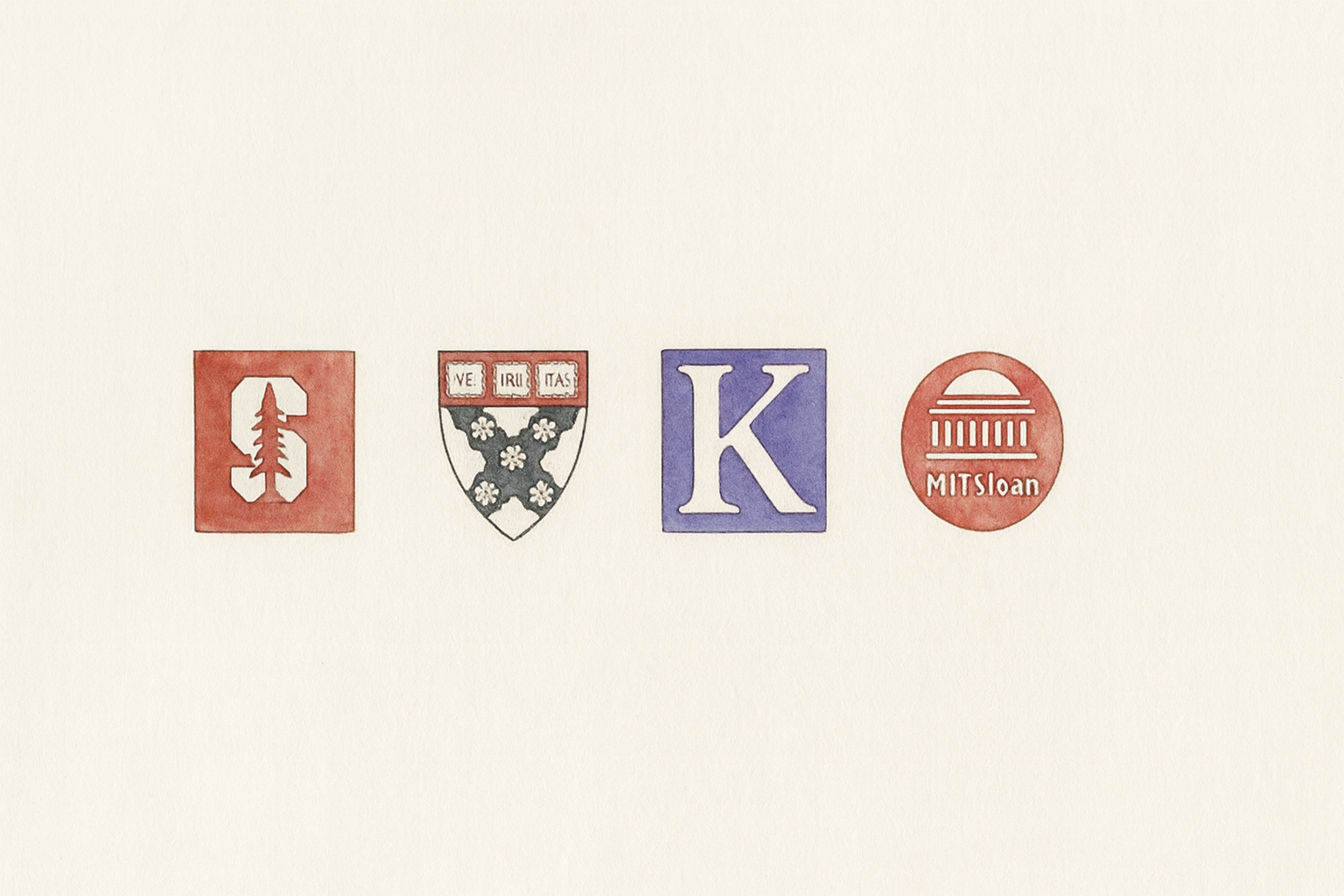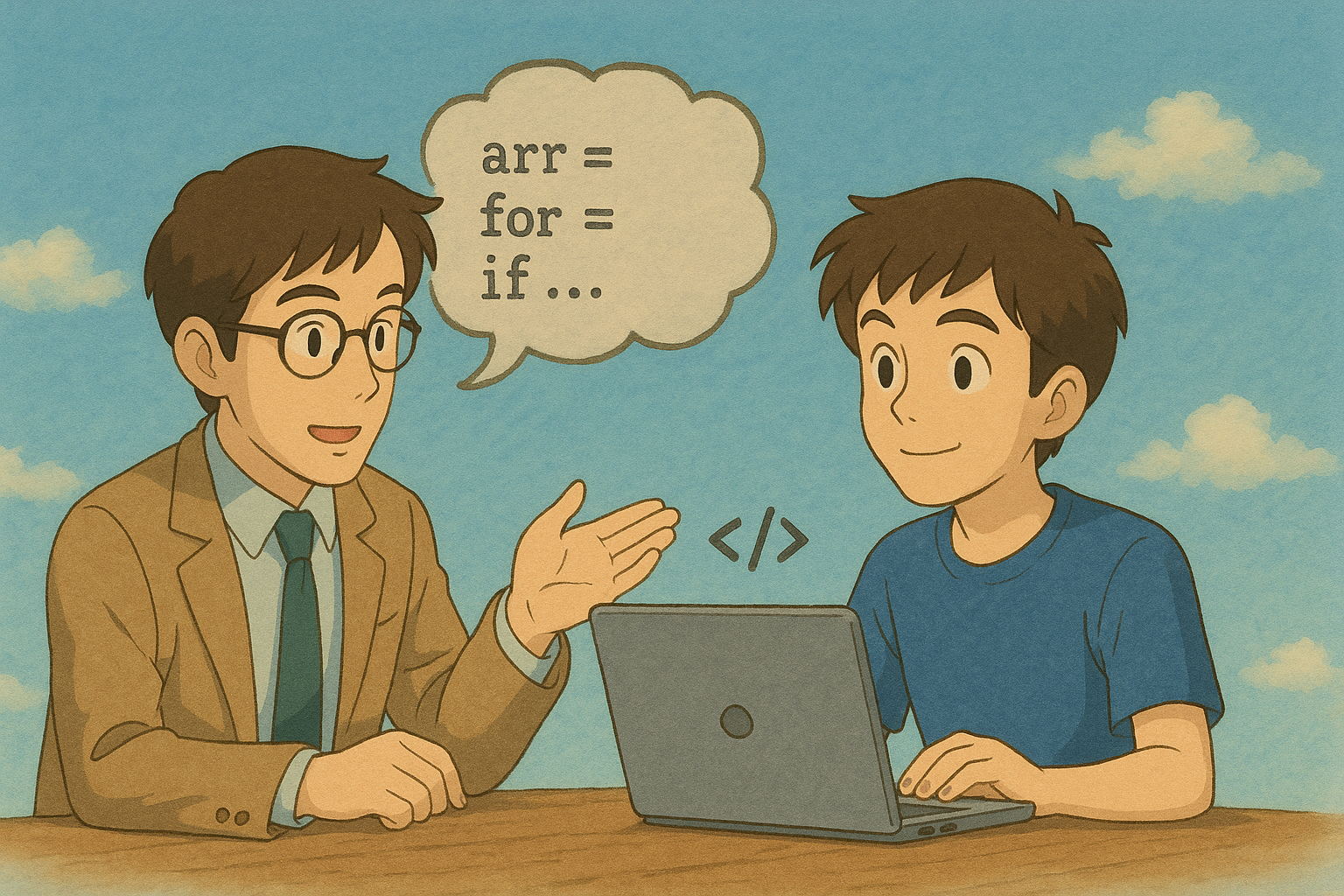All blogs · Written by Ajitesh
Cracking the MBA Personal Statement Questions

Writing an MBA personal statement feels like distilling your entire professional identity into 750 words while simultaneously predicting your future and proving you’ve done extensive research on every target school. No pressure, right?
Over the years, I’ve found myself guiding countless MBA aspirants—people who reach out on LinkedIn seeking advice, friends navigating applications, and during my stint as a part-time admissions consultant. Through these conversations and mentoring sessions, I’ve seen brilliant candidates struggle to articulate their stories effectively. The gap isn’t intelligence or experience; it’s understanding what admissions committees actually evaluate and having a systematic approach to address each element.
That’s why we’ve embedded this entire framework into an AI-powered Personal Statement Coach that guides you step-by-step through crafting your essay. Unlike generic writing tools, our coach has memory—it learns your background, tracks your progress, and helps you connect your unique experiences into a coherent narrative that resonates with admissions committees. Think of it as having an expert consultant who remembers every conversation and helps you polish your story until it shines.
Your AI-Powered Personal Statement Coach
Before diving into the framework, let me explain how our AI coach transforms this guide into actionable results. When you start a session, the coach:
- Analyzes your resume using advanced PDF parsing to identify key inflection points and transferable skills
- Guides you through our proven Past → Future → Present framework with structured checklists and real-time feedback
- Challenges vague goals and helps you apply the R-F-I-G-C formula until your objectives are crystal clear
- Remembers your progress across sessions, building on previous conversations to deepen your narrative
- Provides school-specific guidance based on actual recruitment data and program strengths
This isn’t just about checking boxes—it’s about discovering and articulating your authentic story in a way that demonstrates readiness for business school. The AI coach acts as your strategic thought partner, pushing you to be specific where you’re vague, authentic where you’re generic, and compelling where you’re merely competent.
Ready to craft a personal statement that stands out? Let’s dive into the framework that has helped hundreds of candidates gain admission to top programs.
Practice with our AI Personal Statement Coach
1. Why the Personal Statement Matters
Admissions committees use this single essay to judge three things at once:
- Clarity of direction – whether you can connect past work, future goals, and the program’s offerings in one coherent arc
- Authenticity – whether the voice sounds like a reflective human, not a brochure
- Fit – whether you understand why this particular MBA community is the right platform for your next move
Think of the statement as your “business case” for investing two years (and a lot of tuition) in you.
2. Core Framework: Past → Future → Present
This framework establishes context before you explain goals and school fit.
Past (≈ 15-35% of word count)
Selectively highlight 2–3 inflection points—promotions, industry switches, or outsized projects—that reveal momentum and transferable skills.
- Avoid resume repetition; focus on decisions made and lessons learned, not job descriptions
- Career-changers: spotlight experiences that seed the skills or insight you will leverage in the new field
Future (≈ 35-45%)
Short-Term Goals: Achievable & Precise
Apply the “R-F-I-G-C” Formula:
- Role: “Senior Product Manager” - Shows level & function
- Function: “AI-driven fintech analytics” - anchors expertise
- Industry: “Payments” - Aligns with recruiter data
- Geography: “Singapore hub” - Proves market homework
- Company Targets: “Stripe / GrabFin” - Signals feasibility
Requirements:
- Must be specific and build on pre-MBA skills
- Should exist in recruiter reports
- Timeline: 2-3 years post-MBA
- Avoid jumping two ladders at once (industry AND function) without a bridge role
Long-Term Vision: Ambitious Yet Plausible
Start with Impact, Not Job Title:
- Weak: “Become CMO of a tech company.”
- Strong: “Lead an EdTech platform that upskills 10 million Asian mid-career workers, closing the region’s AI-talent gap.”
Use the “Layered Trajectory”:
- 5-Year Milestone – “Regional GM, Southeast Asia.”
- 10-Year Vision – “Found global EdTech marketplace.”
Validate With Evidence:
- Cite industry tailwinds (e.g., ASEAN digital-learning spend growing >20% CAGR)
- Reference exposure—volunteer board work, prior side hustle—that proves genuine passion
Mini-Case Illustration: Before: “Short-term, I’ll work in consulting; long-term, I want to start a social enterprise.” After: “Within three years of graduation, I will join Bain’s Performance-Improvement Group in Jakarta to streamline supply-chain emissions for agritech clients. By 2035, leveraging these operational insights and the GSB’s Seed Network, I will launch Verdant Grain, a B-Corp that cuts smallholder post-harvest loss by 30% across ASEAN.”
Present (≈ 25-35%) – Why MBA, Why Now, Why This School
Why MBA? — Prove the Skill-Gap
Define the Gap in Three Dimensions:
Knowledge
- Quant, analytics, strategy: “I run P&Ls but lack formal modeling training.”
- Solution: Data-heavy core & electives (e.g., Wharton’s Data-Driven Decision-Making)
Leadership & EQ
- Gap: Led small pods but never managed cross-functional orgs
- Solution: Structured labs & feedback loops (Kellogg L-Lab, HBS FIELD)
Global / Network
- Gap: Career has been APAC-only; need global peers & emerging-market cases
- Solution: International treks, multi-campus projects, global alumni
Use the Math Formula: “My Life Now” + Specific MBA resources = “Life I Want”
Show You’ve Exhausted On-the-Job Options: Explain how mentoring, MOOCs, or rotational stints helped but plateaued; the MBA is therefore the only efficient next lever.
Why Now? — Nail the Timing Trigger
Common Catalysts (Pick One That’s Real):
- Promotion Ceiling: “At EY-Parthenon I cannot progress from Senior Associate to Manager without a master’s-level credential.”
- Market Inflection: “Gen-AI is rewriting ad-tech; missing the 2025 intake means falling behind first movers.”
- Succession Plan / Family Biz: “My father plans to retire by 2028, and I must modernize our supply chain before then.”
- Macrocycle Opportunity: “MBA demand is surging again in the softer job market, widening access to top recruiters.”
Show Evidence of Momentum: Quantify traction right now—KPIs you’ve hit, teams you lead—which makes the MBA a logical springboard rather than an escape hatch.
Why This School? — Demonstrate Exclusive Fit
Do the “Only Here” Audit For each resource you list, finish the sentence “…and I cannot replicate this elsewhere because ___.” Example: “Only Columbia’s Entrepreneurial Sounding Board pairs founders with NYC venture mentors weekly—vital for stress-testing my marketplace pitch.”
Reference First-Hand Touchpoints Aim for three touchpoints:
- Class you sat in (e.g., Prof. Stine’s Statistical Modeling)
- Student or alum quote that influenced your plan
- Club event where you both learned and added value (e.g., volunteered insights at VCIC practice)
Show Dual Contribution Outline how you’ll use that unique resource and what you’ll give back — industry speaker contacts, workshop leadership, mentoring under-represented classmates. In most cases, adcoms know the unique resources; what you add is how you will use and how you will contribute.
Weave Culture & Geography Mention elements like Tuck’s small-town immersion or Kellogg’s Midwestern team ethos only if you connect them to your working style or life goals. Generic praise reads as flattery.
3. Writing Best Practices
- Specificity is Key: The more specific (e.g., “Bain Performance-Improvement Group, heavy-industry focus”) the better
- Show, Don’t Tell: A claim (“I lead with empathy”) gains power only when paired with a narrative snapshot—e.g., mediating a 20-engineer standoff that rescued a launch date
- Precision Beats Poetry: Use concrete metrics—revenue saved, headcount led, users reached—to indicate scale
- Authenticity Over Conformity: Ad-coms spot “manufactured goals” immediately. Write the future you genuinely want
- Community Contribution: Even when the prompt doesn’t ask, weave in how your background or passions will add value
- Bridge Sentences: Connect goals to resources: “My five-year stint building Stripe’s APAC analytics will position me to democratize fintech education across emerging markets.”
Tip: If you truly have two plausible paths, state both and link each to the same overarching mission; optionality conveys thoughtfulness, not indecision.
4. Common Pitfalls
- The résumé regurgitation – wastes word count and bores the reader
- Buzz-word salad – “synergy,” “blockchain,” “AI” without context dilutes impact
- School-agnostic copy-paste – signals low commitment; each essay must feel impossible to recycle
- Goal disconnect – short-term marketing → long-term hedge-fund founder confuses logic
- Flattery without substance – “top-ranked faculty!” fails; tailored linkage wins
5. Five-Stage Writing Roadmap
- Brainstorm: List pivotal stories, quantify wins, clarify motives
- Outline: Map Past-Future-Present spine; assign word budgets
- Draft #1: Write fast, ignore length for now; focus on flow
- Revise: Cut repetition, add specifics, tighten openings/closings
- Peer & Expert Review: Solicit feedback from mentors or consultants; proof for tone, grammar, and school fit
6. Sample Essay Structure (≈ 600–750 words)
- Hook (50 words): Anecdote or statistic that previews your theme
- Past Career Snapshot (120): Two achievements + insight gained
- Short-Term Goal (90) – Specific role, industry, and impact
- Long-Term Vision (70) – Bigger mission and rationale
- Why MBA & Why Now (110) – Skill gaps + timing catalyst
- Why [School] (130) – 3–4 resources; weave in culture fit and contribution
- Closing (30) – Tie back to hook; reaffirm readiness and enthusiasm
Adjust word allocations to fit each school’s limit.
7. Sample Micro-Template (≈ 250 words)
Why MBA (2-3 sentences): “Running a $15M P&L exposed my gaps in predictive analytics and cross-border deal-making. Booth’s Data Mining plus its Global New Venture Challenge will close both.”
Why Now (2 sentences): “Our CEO retires in 2028; the board expects GM succession candidates to present a five-year AI roadmap next spring. Entering Booth this autumn lets me prototype that plan during the 2026 lab.”
Why Booth (3-4 sentences): “A campus visit to Prof. Goldstein’s ‘Art of Medium Maximization’ showed me how data-driven marketing marries creativity—exactly my career sweet spot. Conversations with Kilts Center fellows confirmed I can mine CPG datasets for my thesis, while the Booth Marketing Group’s Chile trek will test learnings in an emerging market. In return, I’ll bring six years of APAC brand-launch experience to enrich case debates and mentor first-years aiming for SEA growth roles.”
8. Master Quality-Control Checklist ✅
Goals Section
| Item | Short-Term | Long-Term |
|---|---|---|
| Role & Function Named? | ✅ | ✅ (higher-level or new venture) |
| Industry & Geography Specified? | ✅ | Optional macro-region |
| Skills Gap Mapped to MBA Resources? | ✅ | ✅ |
| Metrics / Scale Cited? | ✅ (e.g., “manage 3-product P&L”) | ✅ (users served, $ raised) |
| Impact Narrative Present? | ⚪ | ✅ |
| Plausibility Test Passed? | Recruiter data supports role | Logical build from ST + market trend |
Why MBA, Why Now, Why This School
- Each skill gap explicitly maps to a named MBA resource
- A dated trigger justifies timing (promotion cycle, market change)
- At least three school-exclusive resources cited, each tied to your plan
- At least one concrete way you will contribute to the community
- No generic superlatives (“world-class,” “renowned faculty”) without context
Overall Essay Quality
- Clear, specific short- and long-term goals tied to past experience
- Concrete numbers illustrating scope and results
- One vivid personal story showing leadership or initiative
- Seamless transitions; no bullet-point feel
- Tone: confident yet humble; professional yet personal
- Proofread aloud; zero typos or awkward phrasing
Key Reminders
- In general, short-term goals should be high-confidence achievable and long-term should show aspiration and passion
- Ad-coms say vague goals signal an applicant hasn’t researched the market or the school’s career resources
- MBA placement data confirm that ~70% of grads land within the firms they name when the list is realistic
- It’s bad idea to name a start-up that hires just two MBAs a year unless you show inside access
- For skill gap: Pair each bullet of the goal with the exact course, lab or trek you will use
- Link to the School’s Calendar: If the program offers spring treks or a J-term dovetailing with your industry’s hiring cycle, say so; it proves tactical planning
- Loop Back: Close by linking to personal values (Stanford’s “What matters most?“)
- Your vision should be big enough to energize Adcoms “positive impact” ethos but reasonable enough that peers can picture you there
How Our AI Coach Accelerates Your Success
Writing a compelling personal statement is iterative—it requires multiple drafts, constant refinement, and honest feedback. Our AI Personal Statement Coach accelerates this process by:
Structured Guidance
The coach breaks down the overwhelming task into manageable sessions:
- Session 1: Resume analysis and framework introduction
- Session 2: Crafting your “Past” narrative with compelling inflection points
- Session 3: Defining crystal-clear short and long-term goals
- Session 4: Building your Why MBA/Why Now/Why School argument
- Session 5: Integration, polish, and final quality checks
Real-Time Feedback
Instead of waiting days for consultant feedback, get instant guidance:
- Challenge vague goals: “Senior role in tech” becomes “Senior Product Manager, AI-driven fintech analytics at Stripe Singapore”
- Spot missing elements: “You’ve explained why MBA but not why now—what’s your timing trigger?”
- Ensure school fit: “You mention Wharton’s finance strength generically—which specific courses address your modeling gap?”
Memory That Matters
Unlike generic AI tools, our coach remembers:
- Your career progression and key achievements
- Goals you’ve refined across sessions
- School research you’ve completed
- Feedback you’ve received and implemented
This continuity means each session builds meaningfully on the last, creating a coherent narrative that deepens over time.
Practice Makes Perfect
The coach provides:
- Sample before/after transformations showing weak vs. strong goal statements
- School-specific resource examples to inspire your research
- Structured checklists ensuring you’ve covered all critical elements
- Mock review sessions highlighting areas for improvement
Start Your Personal Statement Journey Today
Your MBA personal statement is too important to leave to chance or last-minute scrambling. With our AI Personal Statement Coach, you have an expert guide available 24/7 to help you craft an essay that authentically represents your potential and resonates with admissions committees.
The framework in this guide provides the structure; our AI coach brings it to life with personalized guidance tailored to your unique background and aspirations.
I would recommend this as a precursor to meeting a MBA Admission Consultant so that you figure out your story beforehand and have a more informed discussion with your MBA consultant.
Begin working with your AI Personal Statement Coach
Follow this blueprint with our AI coach’s guidance, and your personal statement will read like a case study of your own potential—exactly what admissions officers want to invest in.
About the author: Ajitesh is a Kellogg School of Management graduate (2020) and founder & CEO of Tough Tongue AI. Drawing from his own MBA application journey, countless LinkedIn conversations with aspiring applicants, and his experience as a part-time admissions consultant, he’s gathered unique insights into what makes personal statements resonate with admissions committees. These years of guiding friends and strangers alike through the complex process of articulating their stories have shaped the AI-powered framework that helps candidates craft authentic, compelling narratives.



